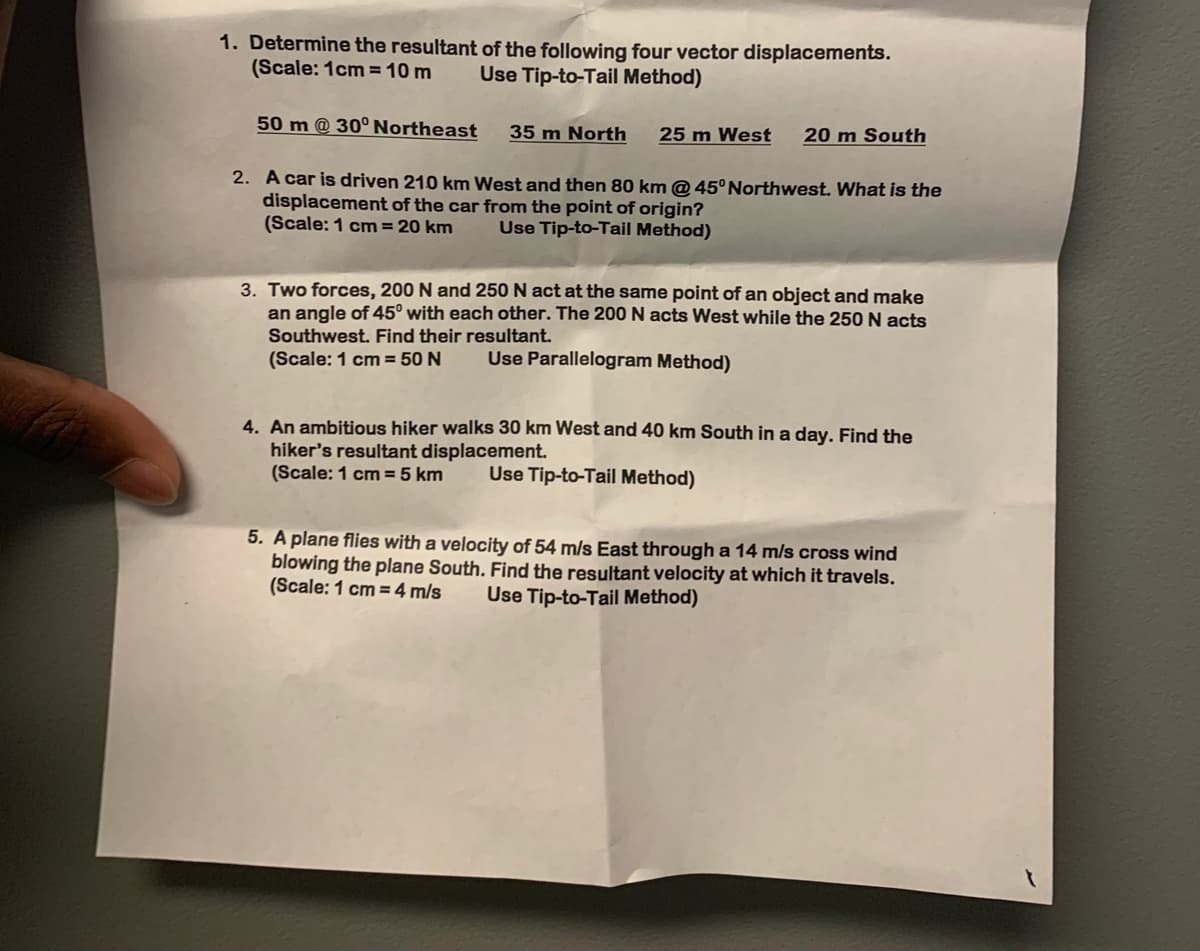50 m @ 30° Northeast 35 m North 25 m West 20 m South 2. A car is driven 210 km West and then 80 km @ 45° Northwest. What is the displacement of the car from the point of origin? (Scale: 1 cm = 20 km Use Tip-to-Tail Method)
50 m @ 30° Northeast 35 m North 25 m West 20 m South 2. A car is driven 210 km West and then 80 km @ 45° Northwest. What is the displacement of the car from the point of origin? (Scale: 1 cm = 20 km Use Tip-to-Tail Method)
Physics for Scientists and Engineers: Foundations and Connections
1st Edition
ISBN:9781133939146
Author:Katz, Debora M.
Publisher:Katz, Debora M.
Chapter3: Vectors
Section: Chapter Questions
Problem 50PQ: An aircraft undergoes two displacements. If the first displacement is directed at an angle of 225...
Related questions
Question
Please answer #2

Transcribed Image Text:1. Determine the resultant of the following four vector displacements.
(Scale: 1cm = 10 m
Use Tip-to-Tail Method)
50 m @ 30°Northeast
35 m North
25 m West
20 m South
2. A car is driven 210 km West and then 80 km @ 45° Northwest. What is the
displacement of the car from the point of origin?
(Scale: 1 cm= 20 km
Use Tip-to-Tail Method)
3. Two forces, 200 N and 250 N act at the same point of an object and make
an angle of 45° with each other. The 200 N acts West while the 250 N acts
Southwest. Find their resultant.
(Scale: 1 cm = 50 N
Use Parallelogram Method)
4. An ambitious hiker walks 30 km West and 40 km South in a day. Find the
hiker's resultant displacement.
(Scale: 1 cm = 5 km
Use Tip-to-Tail Method)
5. A plane flies with a velocity of 54 m/s East through a 14 m/s cross wind
blowing the plane South. Find the resultant velocity at which it travels.
(Scale: 1 cm = 4 m/s
Use Tip-to-Tail Method)
Expert Solution
This question has been solved!
Explore an expertly crafted, step-by-step solution for a thorough understanding of key concepts.
This is a popular solution!
Trending now
This is a popular solution!
Step by step
Solved in 2 steps with 2 images

Knowledge Booster
Learn more about
Need a deep-dive on the concept behind this application? Look no further. Learn more about this topic, physics and related others by exploring similar questions and additional content below.Recommended textbooks for you

Physics for Scientists and Engineers: Foundations…
Physics
ISBN:
9781133939146
Author:
Katz, Debora M.
Publisher:
Cengage Learning

Physics for Scientists and Engineers with Modern …
Physics
ISBN:
9781337553292
Author:
Raymond A. Serway, John W. Jewett
Publisher:
Cengage Learning

University Physics Volume 1
Physics
ISBN:
9781938168277
Author:
William Moebs, Samuel J. Ling, Jeff Sanny
Publisher:
OpenStax - Rice University

Physics for Scientists and Engineers: Foundations…
Physics
ISBN:
9781133939146
Author:
Katz, Debora M.
Publisher:
Cengage Learning

Physics for Scientists and Engineers with Modern …
Physics
ISBN:
9781337553292
Author:
Raymond A. Serway, John W. Jewett
Publisher:
Cengage Learning

University Physics Volume 1
Physics
ISBN:
9781938168277
Author:
William Moebs, Samuel J. Ling, Jeff Sanny
Publisher:
OpenStax - Rice University

College Physics
Physics
ISBN:
9781285737027
Author:
Raymond A. Serway, Chris Vuille
Publisher:
Cengage Learning

Physics for Scientists and Engineers, Technology …
Physics
ISBN:
9781305116399
Author:
Raymond A. Serway, John W. Jewett
Publisher:
Cengage Learning

Physics for Scientists and Engineers
Physics
ISBN:
9781337553278
Author:
Raymond A. Serway, John W. Jewett
Publisher:
Cengage Learning